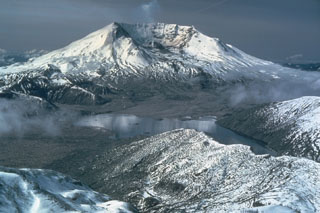Report on St. Helens (United States) — September 1984
Scientific Event Alert Network Bulletin, vol. 9, no. 9 (September 1984)
Managing Editor: Lindsay McClelland.
St. Helens (United States) New lobe in collapse zone on composite dome
Please cite this report as:
Global Volcanism Program, 1984. Report on St. Helens (United States) (McClelland, L., ed.). Scientific Event Alert Network Bulletin, 9:9. Smithsonian Institution. https://doi.org/10.5479/si.GVP.SEAN198409-321050
St. Helens
United States
46.2°N, 122.18°W; summit elev. 2549 m
All times are local (unless otherwise noted)
The new lobe, which began to emerge during the night of 9-10 September and had stopped growing by the 14th, partially filled an elongate E-W-trending collapse zone, about 350 m long by 250 m wide, on the dome's upper W side. The collapse, in what had been the highest part of the dome, destroyed much of the March 1984 lobe and engulfed the notch produced by explosions in May (SEAN 09:05). The SE wall of the collapse zone was defined by the zone of fissuring observed in early September. The volume of collapse was about 1.3 x 106 m3.
The new lobe was about 250 m long by 220 m wide, with an average thickness of 35 m. The USGS calculated its volume at about 2 x 106 m3. It was almost entirely confined within the collapse zone, although it protruded considerably above the rim of the collapse zone. Sublimate deposits were more extensive than on previous lobes, and a large area at the top of the new lobe was a dirty yellow color.
At least 3.4 x 106 m3 of internal expansion of the dome took place during the period of accelerating deformation prior to extrusion of the new lobe. Between the afternoon of 9 September and the next morning, targets on the NW side of the dome moved outward as much as 52 m. Displacement rates dropped sharply on the 10th, and by 11 September outward movement was occurring at only centimeters per day. Deformation remained very slow through early October.
After increasing sharply to 786 t/d on 10 September shortly after the new lobe was first observed, rates of SO2 emission declined to less than 300 t/d on the 12th, less than 200 t/d the next afternoon, and just under 100 t/d by the 15th. A period of higher SO2 emission rates occurred in late September, with measurements on the 23rd, 26th, and 28th yielding values of 190, 135, and 148 t/d, but SO2 values had dropped to less than 50 t/d on 2 October.
Seismicity gradually declined 11-12 September, from about 20 events per hour on the 11th to about 5 per hour late on the 12th, after very vigorous activity the previous two days (SEAN 09:08). Most earthquakes had stopped by 13 September, but surface events, primarily caused by rockfalls, were frequent that day and remained frequent for the next week. The number of surface events declined by the last week in September and seismic activity remained low through early October.
Geological Summary. Prior to 1980, Mount St. Helens was a conical volcano sometimes known as the Fujisan of America. During the 1980 eruption the upper 400 m of the summit was removed by slope failure, leaving a 2 x 3.5 km breached crater now partially filled by a lava dome. There have been nine major eruptive periods beginning about 40-50,000 years ago, and it has been the most active volcano in the Cascade Range during the Holocene. Prior to 2,200 years ago, tephra, lava domes, and pyroclastic flows were erupted, forming the older edifice, but few lava flows extended beyond the base of the volcano. The modern edifice consists of basaltic as well as andesitic and dacitic products from summit and flank vents. Eruptions in the 19th century originated from the Goat Rocks area on the N flank, and were witnessed by early settlers.
Information Contacts: D. Swanson, C. Mullins, USGS CVO, Vancouver, WA; C. Jonientz-Trisler, University of Washington.

